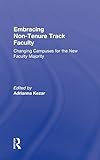Embracing non-tenure track faculty : changing campuses for the new faculty majority / edited by Adrianna Kezar.
Publication details: New York : Routledge, 2012.Description: xxiv, 232 p. : ill. ; 24 cmISBN:- 9780415891134 (hbk.)
- 9780415891141 (pbk.)
| Item type | Current library | Home library | Collection | Call number | Materials specified | Copy number | Status | Date due | Barcode | |
|---|---|---|---|---|---|---|---|---|---|---|
| AM | PERPUSTAKAAN TUN SERI LANANG | PERPUSTAKAAN TUN SERI LANANG KOLEKSI AM-P. TUN SERI LANANG (ARAS 5) | - | LB2331.72.E435 (Browse shelf(Opens below)) | 1 | Available | 00002098615 |
Browsing PERPUSTAKAAN TUN SERI LANANG shelves, Shelving location: KOLEKSI AM-P. TUN SERI LANANG (ARAS 5) Close shelf browser (Hides shelf browser)

|

|

|

|

|
No cover image available |

|
||
| LB2331.72.A25 Academic labor markets and careers / | LB2331.72.B64 Beyond the ivory tower : social responsibilities of the modern university / | LB2331.72.B67 American professors : a national resource imperiled / | LB2331.72.E435 Embracing non-tenure track faculty : changing campuses for the new faculty majority / | LB2331.72.G545 2010 A guide to faculty development / | LB2331.73.M6E24 Improving undergraduate education through faculty development / | LB2331.74.F8B6813 HOMO academicus |
Includes bibliographical references and index.
'The nature of the higher education faculty workforce has radically and fundamentally changed from primarily full-time, tenured or tenure-track faculty to contingent faculty. Regardless of full or part-time appointments, contingent faculty share a common status: short-tem contracts, lack of job security, lack of a professional career track, and limited support on campus. We know little about efforts to support contingent faculty beyond broad, relatively uninformative survey data. While a few sources have developed recommendations for supporting contingent faculty, no resources have documented the real changes occuring on campuses and the challenges that occur while implementing new policies and practices. Improving Contingent Faculty Relations presents real cases where these new policies and practices have been implemented, unveiling the mechanisms that are required to create change, the challenges and opportunities that implementers face, and how effective methodology depends upon particular campus contexts. Readers will learn the various pathways to new policies and practices and can align their strategies with proven approaches. Contingent faculty contributors document from first-hand experience the change process on their campuses. Kezar supplements these case studies by distilling trends and patterns from a national study of campuses that have successfully implemented policies to improve conditions for nontenure track faculty. This book is essential reading for both contingent faculty and higher education administrators'-- Provided by publisher.
There are no comments on this title.

